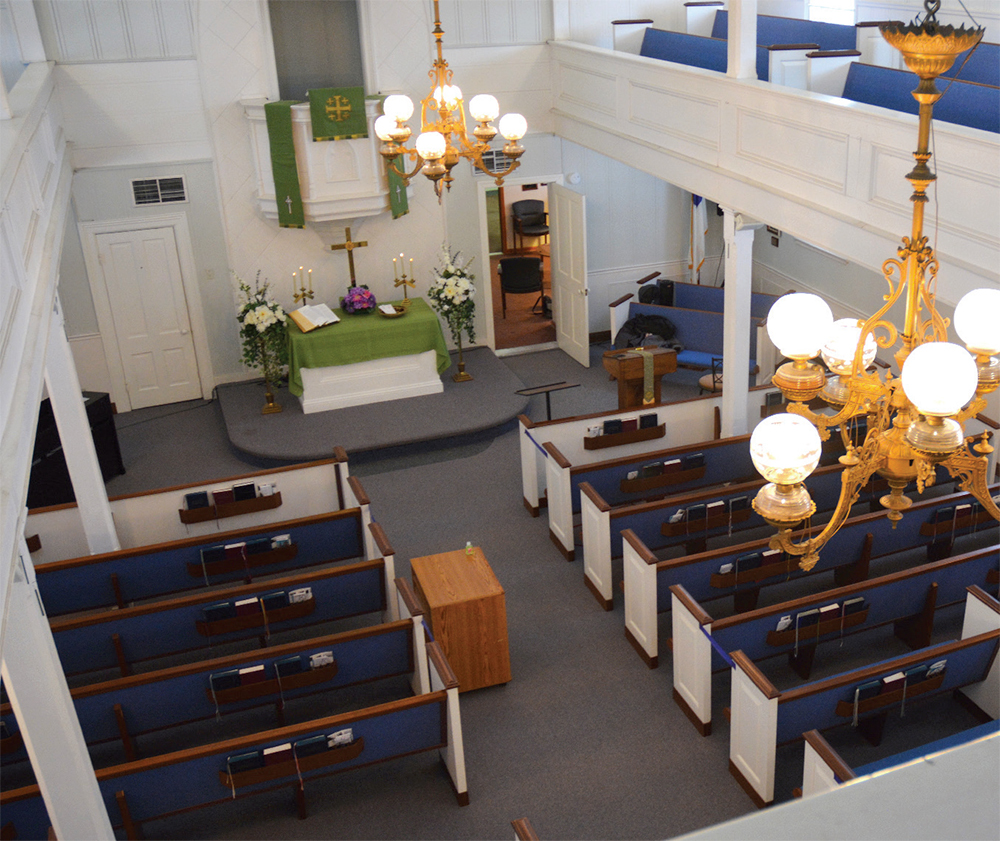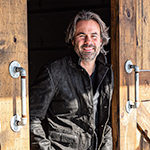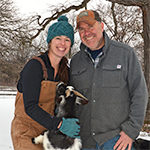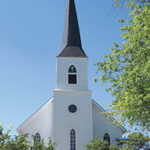Research has revealed that at different times the church has been known as St. John’s German Evangelical Church, Plum Grove Church, Highland Grove Church, Wycliffe Church, The Church at Wycliffe, St. John Evangelical Church, United Evangelical Congregation at Wickleffe, St. John Evangelical Reform, and currently St. John United Church of Christ. It has always been a church, a place to worship the Lord.
As lighthouses stand on headlands, beacons to those on stormy seas, so church spires stood as beacons on the open prairies of mid-19th century America, landmarks for the settlers in their scattered and lonely cabins.
They had come from afar. They had come by steamship across a turbulent ocean and ventured on unknown great lakes. They had come by horse-drawn wagons and on horseback. Sometimes they had walked. They crossed creeks and forded rivers to arrive where stands of timber provided logs to build cabins, a general store, which was often the post office, an inn, and a blacksmith shop. From these hamlets they laid claim to the available tracts of government land, broke the prairie, and prayerfully started their new lives in territories where few of their ilk had gone before.
In the early 1840s, the area around the present-day Algonquin, Roselle, and Ela Roads was variously known as Highland Grove, Missionary Grove, or Wickliffe from the first English families who came there. Algonquin Road was well traveled, it was part of the Chicago to Dundee and Rockford mail and stage route, and the Wickliffe Hotel was busy, a welcome stop for travelers; often several covered wagons with new settlers rested there overnight.
The English were soon joined by a significant number of Germans, and it was they who organized worship services, at first in homes, barns, and in the local public schoolhouse of School District #2, near the present-day Ela Road. Organizing as a church in 1846, their first preacher was Missionary Johan Simon Dumser, 29 years old, and fresh from his studies at the Basel Missionary Society in Basel, Switzerland. He lived in Long Grove and traveled on horseback to the various Groves in Palatine Township (not yet so named) where worship congregations were assembling.
A First Parsonage Near Barrington
During this time, the first parsonage was built on land donated by Johann D. Ottman. When the first Church Constitution was adopted on January 22, 1850, the church was officially named “United Evangelical Congregation at Wickliffe, Cook County, Illinois”.
None of our present day towns existed then; small settlements were connected only by wagon trails, some original to the Native Americans and some further established as military routes from Chicago. The intersections of these trails were often named for the first settler there, and thus the St. John congregation’s first address was that of the busy Wickliffe Hotel.
A Church Founding Family
The mid-1850s was a pivotal time for these prairie residents and for the future of the St. John’s congregation. In 1852, one of the most significant families in the history of the church arrived from Germany. Margaretha and Louis Bergman were from the Alsace area of Germany and among the many children who came with them was Daniel, aged 2. Daniel’s descendants would be a continuous link to the founding of the church. Margaretha and Louis’ great-grandson, Harold, celebrated his 100th birthday and the church’s 170th Anniversary with a Service and Luncheon on June 5, 2016.
By 1854, the Illinois and Wisconsin Railway was extended northwestward from Dunton, now Arlington Heights, and the towns of Palatine and Barrington Station were established.
In 1854, too, the first church building was completed near the parsonage, on 1 ¼ acres of land provided by Morgan Johnson, which is part of the current 13 acres of church property. At this time, the church was reorganized under Pastor P. Lehmann and adopted the name St. John Evangelical Church. Pastor Lehmann also urged the congregation to join the Lutheran Synod, but they refused and he resigned. However, in 1863, the Church joined the Synod of the Northwest and become a part of the Evangelical Denomination of the United States.
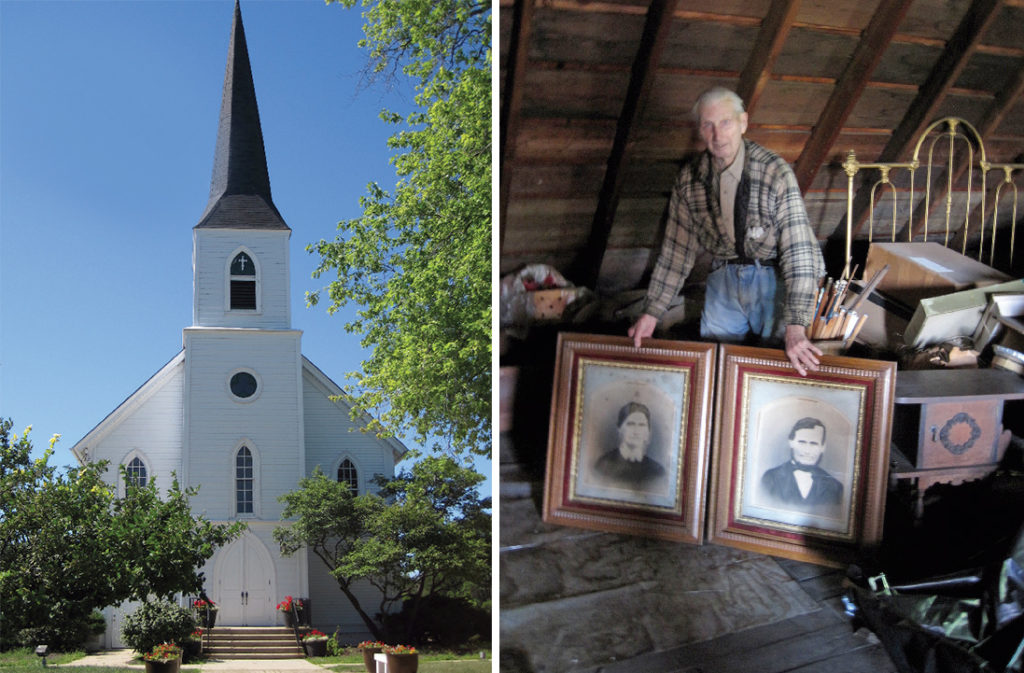
Right: Early church family members came from Germany. Margaretha and Louis Bergman’s great-grandson, Harold Bergman, with images of his parents.
Adding a Church Schoolhouse
By 1865, a Church schoolhouse was built close to the parsonage at a cost of $2,000. This reflected the steady influx of settlers and the growth of Barrington, Palatine, and other towns along what was now the Chicago and Northwestern Railway.
Ten years after the schoolhouse was built, the Congregation had grown to an extent that plans were slowly developed to build a new church. There had been some friction over the site of the first church, and now, agreement was achieved to build the new church east of the parsonage and schoolhouse on Algonquin Road. Voluntary donations for the new building came to $4,730.
The Church cornerstone is dated June 5, 1875, and the new church was built on the site of the present church at what is now 1475 West Algonquin Road, Palatine, Illinois. Christian Brinchman, as chiseled into the cornerstone, was the contractor along with the date of laying the cornerstone. At the Dedication later in the year, Inspector Th. Meusch of Elmhurst College performed the Dedication rites assisted by former Pastor Lehmann who preached the sermon, with other pastors assisting in the service. A special train from Chicago brought worshippers out to enjoy the celebration of this great occasion.
Outfitting the New Church
Of the donated money, the building cost $2,894, and the bell cost $380. Rugs, chandeliers, and other interior furnishings, amounting to $400, were donated by the Ladies of the Congregation. The chandeliers were of brass, and the globes, from which the flames of the lighted candles shone their light outwards, were made of hand-cut German crystal. The church steeple, within which the heavy bell was hung, stood tall over the farms and barns and silos of the surrounding countryside. It was a church built—it was hoped—to last.
When Tragedy Struck
On September 18, 1882, a fire destroyed the parsonage and the schoolhouse on their original site west of the church, and the congregation agreed that they should be rebuilt closer to the church, and at their present site. Fire brought further tragedy and tested the parishioners’ endurance.
In 1885, in the early morning of August 21, lightening struck the church steeple, starting a fire which reduced the church to ashes. Cemetery and other records were burned in the fire. But this congregation did not waiver. On September 14, 1885 a new cornerstone was laid and Christian Brinchman began construction of a new church, identical to the previous one, at a cost $2,700. The dedication ceremony was held on December 20, the Fourth Sunday in Advent. Despite icy roads and snowdrifts, the church was filled to capacity. There are two cornerstones, one mortared atop the northeast corner of the church foundation, the 1885 cornerstone, and a crumbling, almost illegible stone at the northwest corner which is believed to be that of the 1854 church.
The rebuilding was complete when the church’s bell was recast by the Henry McShane Bell Foundry of Baltimore, Maryland, the oldest bell and carillon caster in America, and a new organ was installed for $875. It was built by the organ maker, believed to be Emil Witzmann, inside the church, in the present alcove/loft specially designed to display the decorated metal pipes. Such was the uniqueness of the organ that the Organ Historical Society has given it a Historic Organ Citation.
With a spire that still stood tall above its surroundings, and protected by a lightening rod, the rebuilt church, with its faithful congregation, moved resolutely forward into the new century. In 1911, the Ladies Aid Society and a Young Peoples Choir were organized followed in 1912 by the first Young People’s Society. With the Ladies group, they contributed to the renovation of the church. One of the hallmarks of the church’s longevity has been the good stewardship of its buildings.
But above all, celebration of the church’s own anniversaries, the worship calendar, seasonal festivals, and special occasions in the lives of its members provide a strong environment of permanence and fellowship. At the church’s 75th Anniversary in 1925, the exterior of all the buildings, the church, parsonage, schoolhouse, and garage received a new coat of paint, and a portable generator provided temporary lighting for the evening commemorative service.
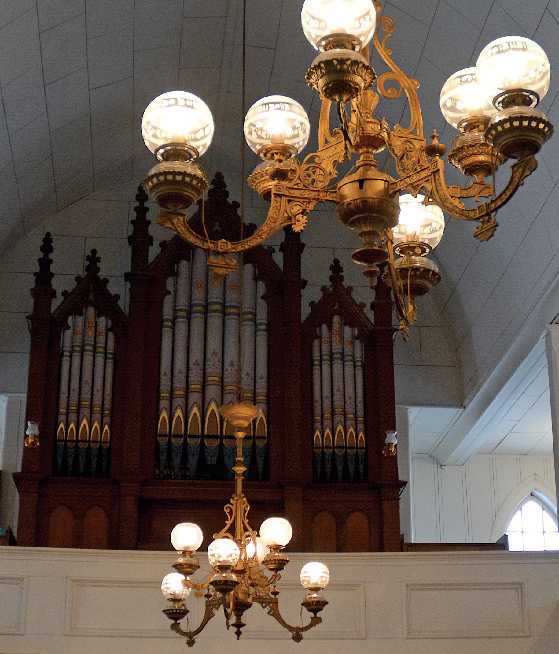
These beautiful chandeliers are original to the church when it was rebuilt following a fire.
German Language Gives Way to English
Given that the population had become more predominantly English speaking, in 1928, English replaced the German language in the church services, and English was used for the first time instead of German in the Confirmation classes and ceremonies.
In 1934, the Reformed and Evangelical denominations merged and took the name of the “Evangelical Church of America”. In 1935, St. John officially changed its name to “St. John Evangelical and Reformed Church”.
The Great Depression and the Second World War saw a decline in the congregation to the point where the church was being supported by 13 families and was “yoking” its pastor with Immanuel Church of Hanover Township. The arrangement worked well, but by 1945, members had returned, the congregation increased again, and the Reverend Peter Beecken became St. John’s pastor. The next few years would see further improvements to the church as it approached its 100th Anniversary.
For this anniversary, Immanuel Church in Hanover Township gifted an inspiring illuminated cross which adorns the chancel above the altar and pulpit. Other celebratory gifts included new hymn boards and books, German and English pulpit bibles, and three offering plates.
The year 1957 saw the solidification of the church’s identity, when it officially became St. John United Church of Christ. It was affiliated with the United Church of Christ, a denomination formed that year through the merger of the Evangelical and Reformed and the Congregational Christian Churches.
Through the next 75 years, St. John’s has continued as a place of worship, hope, sanctuary, and community outreach amid encroaching modern civilization. The church land originating at the intersection of wagon trails, now comprises 13 ½ acres including Mount Hope Cemetery, a Garden Chapel (and once a Labyrinth), tranquil space that is set back from the continuous stream of traffic on Algonquin Road. New on the grounds is a pink wildflower pollinator garden, helping to support the beehive that a local beekeeper maintains on the property.
Just as those first settlers put down their roots here, and raised their voices in praise, now, 175 years later, their descendants honor their past, and embrace the future. The spire of St. John’s United Church of Christ welcomes friends and neighbors, many of whom still come from afar, to find fellowship in the settlers’ church.
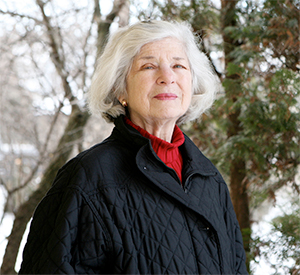
Barbara L. Benson grew up in Kent, England, and later moved to New York. She settled in Barrington and has walked with our history since she first arrived here in 1980.
The Ringing of the Bell
The present bell is dated 1885, and was cast by the McShane Bell Company, founded in Baltimore, Maryland, in 1856. This is the oldest bell and carillon foundry in the United States. Locally, their most visible carillon is at the Chicago Botanic Garden in Glencoe.
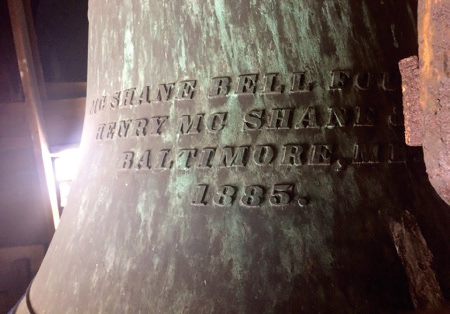
Herman Kolle lived across the road from St. John’s on Kolle Farm, and as an officer of the church living close by, he volunteered to ring the church bell. Every Saturday evening at 6 o’clock, the bell would be rung for 15 minutes as a reminder that tomorrow was the Sabbath, a holy day. Again, on Sunday at 10 a.m., the bell would be rung for about 15 minutes when Sunday school began, and again to remind people that service was at 11 o’clock. At the close of the service, while the Lord’s Prayer was being recited, the tolling hammer struck once of each of three words: “Father, bread, and Amen.” This was a signal for children that their parents would soon be home from church, and to have lunch ready!
When a church member died, it was the custom to ring the bell for half an hour, followed by the tolling hammer striking the bell the number of times equal to the person’s age, followed by another half hour of ringing. If the person was 20 years or younger, the bell was rung for half an hour, followed only by the tolling hammer equal to the age of that young person. Ringing the bell for death was done by one of the deceased’s kin, and those in the fields could count the tolling, often telling them who had died.
Bell tolling is still done at the end of a funeral or memorial service. It rings once for each year the person lived.
St. John’s Outreach
St. John United Church of Christ Outreach activities include:
- Palatine Township Food Pantry
- Thanksgiving Baskets
- Christmas Adopt-a-Family
- Apple Tree-School Supplies
- Feed My Starving Children
- Halloween Drive-Thru Trick or Treat
- Heifer International
- Virtual Organ Recital
- Festival of Giving-Partnering with Palatine Food Pantry, Thomas J. Boyle Memorial Foundation (toys), and Connections for the Homeless (Winter Clothing Items).
St. John UCC – Who We Are
By Reverend Sandra Kolar
We are a small progressive, open, and affirming, congregation of wonderfully imperfect people who strive to be compassionate, caring people. Our roots are in the German Reform tradition. We still enjoy singing the first verse of “Silent Night” in German, we celebrate Totenfest to honor our German farmer founders, and we are famous for our German Potato Salad recipe.
But we are a church with a young heart, centered on God and God’s future. As our world has grown to include people with different backgrounds, multiple perspectives, and wide-ranging interests and life experiences, we believe that God is calling us to approach our devotion, our thinking and awareness, and missions in fresh new ways.
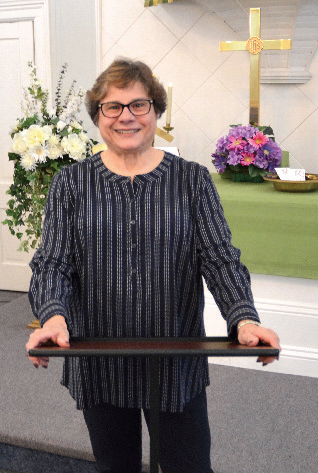
St. John UCC’s Reverend Sandra Kolar. Photo: Susan Mcconnell.
In our denomination, the United Church of Christ, each church has the freedom and responsibility to discern God’s call and how to respond. Our accountability is first to God and then to each other. Similarly, each member has the freedom and responsibility, with God’s guidance, to work out a faith that is meaningful for her or him.
We believe that serving others in love is our highest calling as followers of Jesus. We are committed to serving poor, the hungry, and the marginalized. And we believe that God has blessed each person with unique gifts and talents for service in the church, and that our job is to encourage one another to share and use those gifts. We believe we’ll be successful because “small churches can do great things with love.”
Our Partnership with WINGS
“A faith community of everyday people empowered by a loving God to embrace our diverse world with peace, love, hope and compassion to create a better future.”
This is St. John’s Vision Statement; a bit lofty, perhaps, for a small congregation, but one that we believe we can live and grow into. Part of our responsibility as Christians is to serve others. In today’s world, that means we need to be more fully present in our communities. Although we have always actively served, and will continue those missions, we believe we need to be more involved in new and creative ways that utilize the talents of our congregation and our church’s assets to confront the evils of poverty, injustice, and violence. With a new Vision Statement, our mission is to develop partnerships with other service organizations for new service opportunities.
We are excited about our new relationship with WINGS. A community of volunteers, with different gifts and talents, coming together to transform a property, a family, and a faith community. Our next steps are to deepen our relationship with WINGS on new projects, and to explore opportunities and widen our relationships in the community to bring God’s peace, love, and hope to our communities.
About the Sanfilippo Foundation, St. John United Church of Christ, and WINGS Program Partnership
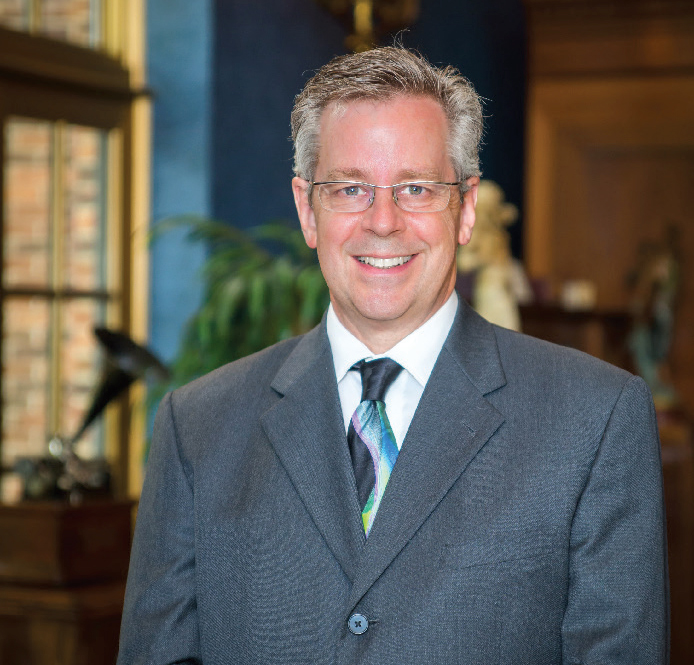
Gregory Leifel, Executive Director, Sanfilippo Foundation. Photo Courtesy of Linda M. Barrett.
The Sanfilippo Foundation’s experience of working with many charities enables it to see the larger picture of how charities can grow individually, and through partnerships. “During a recent fundraising project, one of our charity partners, St. John United Church of Christ in Palatine, made me aware of a home property becoming available,” said Executive Director of the Sanfilippo Foundation Gregory Leifel. “Having a long-term relationship with another charity, WINGS Programs in Palatine, I conceived how they might fulfill their community outreach missions together.”
Leifel made a call to April Graves of LightDrawn Studios in Barrington who is a WINGS Board Member. “The Foundation has worked with April on her “Beautiful Things With Wings” annual fundraising calendar, with LightDrawn Studios donating the proceeds to WINGS Programs. April confirmed WINGS’ need for transitional housing for larger families of domestic violence. The next step was asking both organizations to begin a discussion with a focus on the women and children.”
“WINGS’ Executive Director Rebecca Darr, Laura D’Argo, St. John UCC Communications Director, and I discussed how we could all make this happen with a long-term partnership in mind,” Leifel said.
“WINGS is so grateful to the congregation of St. John Church, the Sanfilippo family, and The Build Team for making a dream come true for our larger families who are seeking long-term housing and support,” Rebecca Darr said “This partnership exemplifies the power of people coming together to help those in need.”
WINGS has experience with other housing rehab projects and reached out to The Build Team, a Barrington nonprofit of retired tradesmen who are helping to rehab the property. “When I first started Dawson Builders in 2006, we had many requests to help people who could not afford to make repairs on their homes,” founder John Dawson said. “So, we formed ‘The Build Team’ and obtained 50(c)3 status, put together a Board and started accepting donations. Still with the same mission (see thebuildteam.org), we provide repair services to people in need at no cost and help people stay in their homes. We have helped over 40 families in 60010,” he said.
After some rehab work, the home will be furnished with items from WINGS’ resale shops and will utilize their volunteer network. WINGS began looking for grants and secured a HUD grant for 2021.
The Sanfilippo Foundation stepped up with a donation of $6,000 for essential fixes, and a donation of $2,300 came in from Sanfilippo friend, Randy Donley of Donley Auction House in Union, Illinois. St. John Church members donated, and flooring was anonymously donated. Further donations and a capital reserve are being sought to continue this important community partnership.
For more information on the WINGS/St. John UCC Partnership, and how you can help, contact: Gregory Leifel, Exec. Dir. of the Sanfilippo Foundation at 847-691-7425 or by email: director@sanfilippofoundation.org.
About the Sanfilippo Foundation, St. John United Church of Christ, and WINGS Program Partnership
– End –
Share this Story

